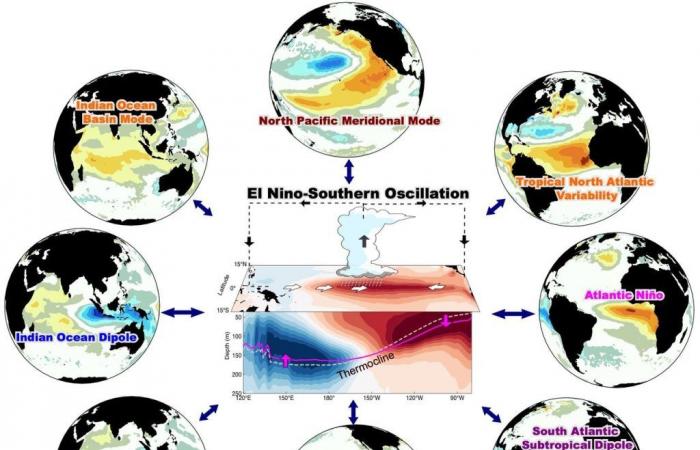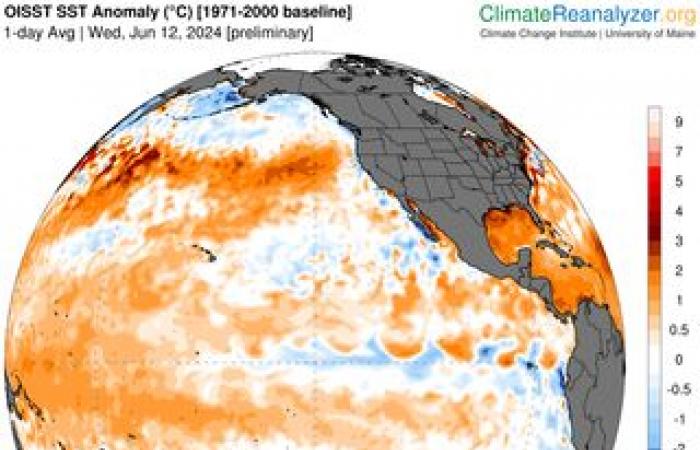In Asia, the Pacific Ocean and America, El Niño Southern Oscillation (ENSO) brings variations in winds, weather and ocean temperatures which can cause droughts, floods, crop failures and food shortages. Recently, the world experienced a major El Niño event in 2023-2024, which had a dramatic impact on weather, climate, ecosystems and economies globally.
ENSO predictions up to 18 in advance
By developing an innovative modeling approach, the researchers of the School of Ocean and Earth Sciences and Technology (SOEST) from the University of Hawaii at Mānoa Now can forecast ENSO events up to 18 months in advancewhich significantly improves the conventional climate model.
Their findings, which combine knowledge of ocean and atmospheric physics with predictive accuracy, were published in Nature.
“We have developed a new conceptual model, the so-called extended nonlinear recharge oscillator model (XRO), which significantly improves the ability to predict ENSO events more than a year in advance, better than global climate models and comparable to the most skillful AI forecasts. “said Sen Zhao, lead author of the study and assistant researcher at SOEST.
“Our model effectively incorporates the fundamental physics of ENSO and the interactions of ENSO with other climate patterns in the global oceans that vary from season to season.“.
Scientists have been working for decades to improve ENSO predictions given its global environmental and socioeconomic impacts. Traditional operational forecasting models have struggled to successfully predict ENSO with lead times longer than one year.
AI helps drive new forecasts
Recent advances in artificial intelligence (IA) have surpassed these limits, achieving Accurate predictions up to 16 to 18 months in advance. However, the nature of “black box” of AI models has prevented attributing this precision to specific physical processes.
Failing to explain the source of predictability in AI models results in low confidence that these predictions will be successful for future events as the Earth continues to warm, changing currents in the oceans and atmosphere.
“Unlike the ‘black box’ nature of AI models, our XRO model offers a transparent view into the mechanisms of the equatorial Pacific’s recharge and discharge physics and its interactions with other climate patterns outside the tropical Pacific,” explained Fei-Fei Jinthe corresponding author and professor of atmospheric sciences at SOEST.
Deficiencies and improvements of the climate model
“Our findings also identify deficiencies in the latest generation of climate models that lead to their failure to accurately predict ENSO.“said Malte Stuecker, assistant professor of oceanography at SOEST and co-author of the study.
“To improve ENSO predictions, climate models must correctly capture the key physics of ENSO and, in addition, three complex aspects of other climate patterns in the global oceans: precise knowledge of the state of each of these climate patterns when forecasts begin of ENSO, the correct seasonally varying ‘ocean memory’ of each of these weather patterns and correct representations of how each of these other weather patterns affect ENSO in different seasons.”
“Different sources of predictability lead to different evolutions of ENSO events“, said Philip Thompson, associate professor of oceanography at SOEST and co-author of the study. “We can now provide skillful, long-term predictions of this ‘ENSO diversity’, which is critical as different types of ENSO have very different impacts on global climate and individual communities.“.
“In addition to El Niño, the new XRO model also improves the predictability of other climate variabilities in the tropical Indian and Atlantic Oceans, such as the Indian Ocean Dipole, which can significantly alter local and global climate patterns beyond the impacts of El Niño.“Zhao added.
Future jobs
The implications of this research are far-reaching and offer insights into more accurate ENSO predictions with longer delivery time and improvements in global climate models.
Although the ENSO phenomenon originates in the tropical Pacific, we can no longer think that it is a problem exclusive to the tropical Pacific Ocean, neither from a modeling and prediction perspective nor from an observation perspective. The global tropics and higher latitudes are critical to improving seasonal climate forecasts.
Reference
Fei-Fei Jin, Explainable El Niño predictability from climate mode interactions, Nature (2024). DOI: 10.1038/s41586-024-07534-6. www.nature.com/articles/s41586-024-07534-6
This entry was posted in News on 27 Jun 2024 by Francisco Martín León








